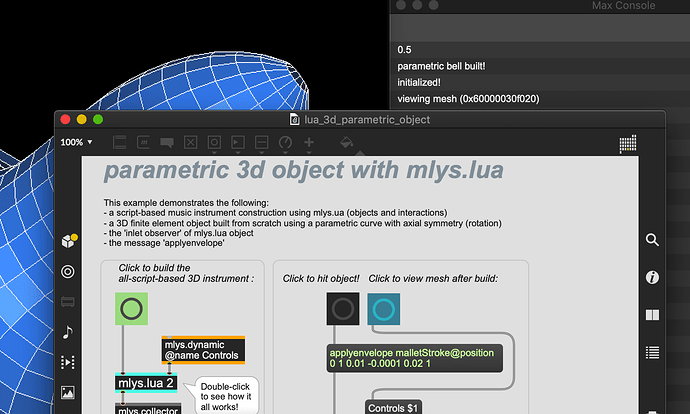Hello Modalys lovers!
Modalys beta v. 3.6.0.b13 is available from the modalys beta project page .
Highlights for this release are:
- Easy creation of 3d sounding objects with parametric curve with mlys.lua (–> “lua_3d_parametric_object” example)
- Many bug fixes (notably in Modalys for Max)
- mlys.lua Max object almost feature complete (–> “lua_test_all” example)
NB: Windows is still a bit behind as I am trying to fix the finite element library compilation there…
Best,
Robert
cumulative notes for Modalys 3.6 beta
3.6.0.b8…b13:
- mlys.lua :
- new ParametricCurve class for easy 3d object construction (see the lua_3d_parametric_object example)
- return value from (update() function) did nothing!
- the dimension parameter of a mlys.lua object is now automatic if “-1” is set (which is by default for new objects).
- mlys.get_info can now return strings (and, of course, numbers)
- bow and felt connections implemented
- moved from luajit to moonjit lib
- new function modalys.view_mesh(–mesh ref–): to invoke Medit
- new object modalys.inlet_observer to monitor inlet updates. With “modalys.inlet_observer.callback = my_callback” you shall assign a callback of your own receiving 2 parameters: inlet# and current float value.
- compatibility with macOS 10.15 Catalina and macOS 11 (Big Sur), including when running under “rosetta2” emulation on a new ARM mac machine.
- fully notarized installer
- recompiled, correctly codesigned Modalisp and Medit
- updated Matlab objects (64bit)
- fixed violin bridge object (long-standing issue…)
- Modalys for Max: an old bug has been fixed that explain some strange past behaviors!
3.6.0.b7:
Modalys for Max
- mlys.lua:
- “mlys” alias namespace created. So instead of “modalys.freq_to_midi”, you may write the more compliant “mlys.freq_to_midi”
- aliases added to functions, to match legacy namings: modalys <-> mlys, make_object <-> create_object,
make_connection <-> create_connection, make_mesh <-> create_mesh, make_point_output <-> create_point_output, extend_mesh <-> create_mesh
3.6.0.b6:
Modalys for Max
- a long-standing request: modifying an attribute in mlys.expression (and now mlys.lua) doesn’t erase the script content anymore!
- mlys.lua:
- improved stability.
- modalys.release now accepts any series of item references. For instance modalys.release(mystring,mymesh,ctrl1)
- new function modalys.compute_modes(–object reference–)
- new function get_pitched_finite_element_object(–parameters–). Parameters are: “mesh”, “name”, “block” (a mesh that describes the fixed nodes), “midinote” or “frequency”, “modes” (amount), “thickness” (for 2D mesh), “density”, “young”, “poisson”, “constloss”, “freqloss”.
- new function modalys.freeze_object(–object reference–) For now, it is only for actual objects (strings, tubes etc.) but the plan is to extend it to access and controllers.
- new function modalys.get_mesh(–object reference–) to get the mesh reference of a given 3D-based object.
- new objects implemented in create_object (more to come…)
- new connections implemented in create_connection (more to come…)
3.6.0.b4:
Modalys for Max
- mlys.lua
- new function modalys.midi_to_freq(–midi note–)
- new function modalys.freq_to_midi(–freq–)
- new function normalised_random()
- new function modalys.create_access(–parameters–). Parameters are: “kind” (normal, trans0 etc.), “where” (object ref), “name”, “location”/“position” (can 1- or 2-dimensional, or a node etc.)
- new function modalys.create_point_output(–parameters–)
- new function modalys.create_object(–parameters–)
- new function modalys.create_connection(–parameters–)
- new function modalys.create_mesh(–parameters–)
- new function modalys.extend_mesh(–parameters–)
- new function modalys.transform_mesh(–parameters–)
- new function modalys.save_mesh(–parameters–). Parameters are: “mesh”, and “path” (can be relative).
- new function modalys.create_connection(–parameters–)


 cheers
cheers )
) (ce qui ne veux rien dire, car je ne suis pas trop qualifié en codage)… mais il me semble qu’au lieu de commencer au 'single-point et continuer avec duplicate 'translation/'rotation etc. on travaille plutôt avec la fonction “ParametricCurve”. Pour à la fin compléter avec “modalys.extend-mesh”, ce qui me semble correspondre au “duplicate 'rotation” qu’on emploie souvent dans modalisp?
(ce qui ne veux rien dire, car je ne suis pas trop qualifié en codage)… mais il me semble qu’au lieu de commencer au 'single-point et continuer avec duplicate 'translation/'rotation etc. on travaille plutôt avec la fonction “ParametricCurve”. Pour à la fin compléter avec “modalys.extend-mesh”, ce qui me semble correspondre au “duplicate 'rotation” qu’on emploie souvent dans modalisp?